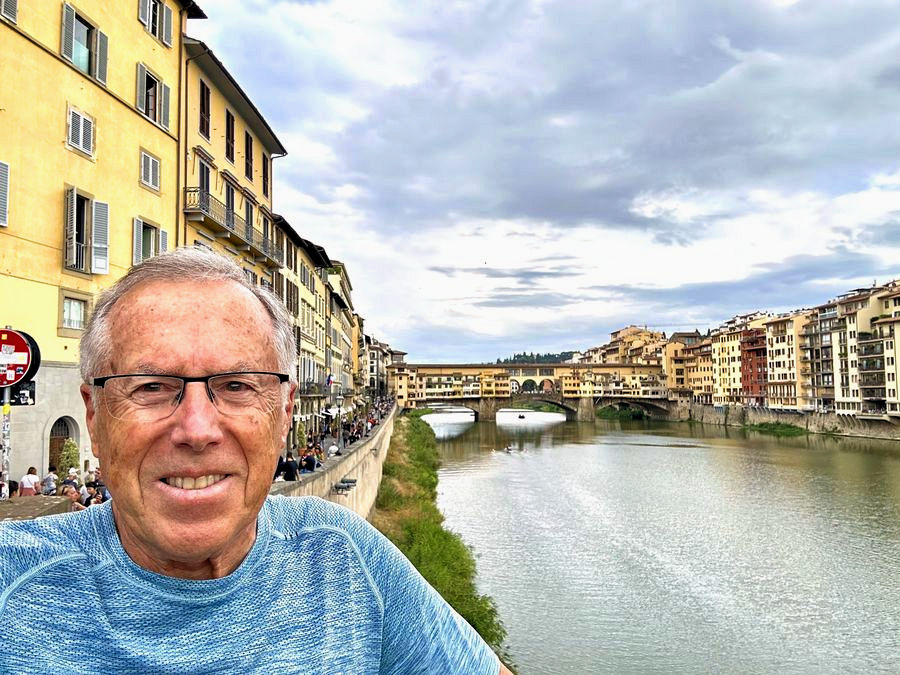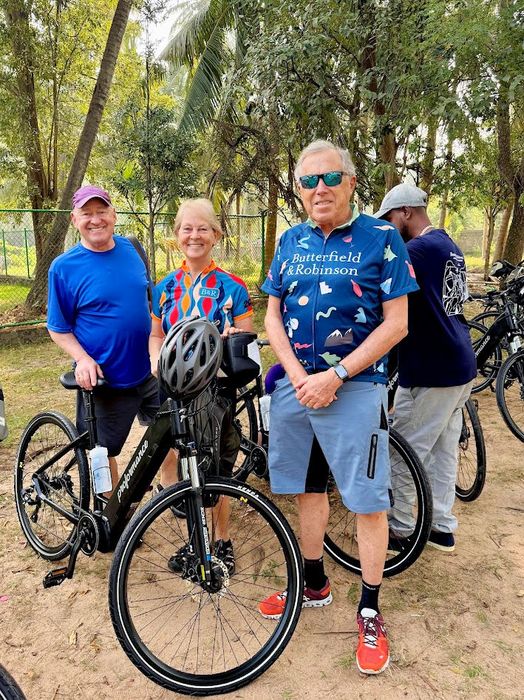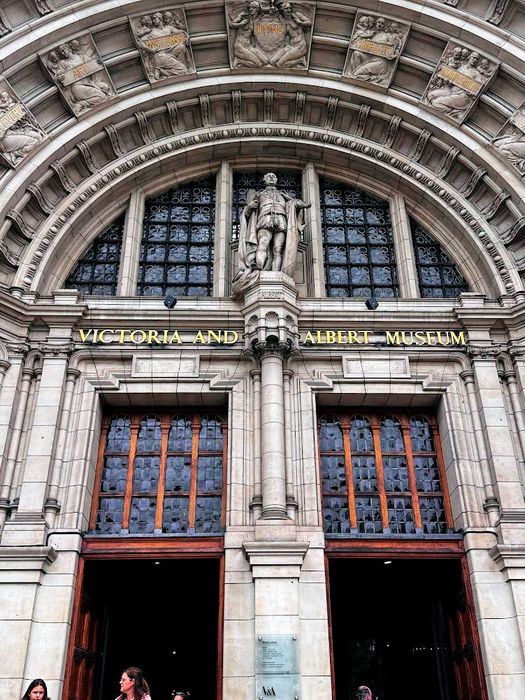JOIN ME FOR A TOUR OF BEAUTIFUL FLORENCE

Florence is one of those totally unique cities which beckons one to return again and again. Like with most beautiful cities in Europe, early visits are like tearing through a museum. Not until later do you really start absorbing what you saw. I was fortunate to return and spend a night before and after a bike tour in Tuscany. Join me on my blissful meanderings in Florence.

I’m next to the Ponte Santa Triniti bridge on the Arno River with a view of the iconic Ponte Vecchio in the background. The statue above, “Spring” by Pietro Francavilla, has an interesting history. Ponte Santa Triniti was ornamented with statues of the Four Seasons on the occasion of the marriage of Cosimo ll de’ Medici to Maria Maddalena of Austria in 1608.
In August 1944 retreating German forces blew up this bridge and two other ancient bridges on the Arno. It was rebuilt between 1952 and 1958. The four statues were also fished out of the river, reassembled and replaced on the bridge. Unfortunately, the head of the statue of Spring, which stands on the north-eastern side of the bridge, could not be found. A local antiquarian offered a reward for its discovery and in 1961 it was finally retrieved and returned to its owner.

The Ponte Vecchio never ceases to amaze me. The bridge has shops built along it. Originally they were mostly butchers, tanners, and farmers who occupied the shops. Today the present tenants are jewellers, art dealers, souvenir sellers,…hundreds of tourists!

The bust of Benvenuto Cellini, (1501-1571), renowned Renaissance artist, adventurer and goldsmith, looks out over the waters of the Arno from a prime position at the centre of the bridge.

I strolled towards the Piazza del Duomo and what is known as the Cathedral of Florence, the Cathedral of Santa Maria del Fiore.

Construction on the church began in 1296 in the Gothic style to a design of Arnolfo di Cambio and was structurally completed by 1436. The dome was engineered by Filippo Brunelleschi. It is the fourth largest church in the wold!

People line up to get into the Church. I always recommend a private guide to the famous churches and museums in the city. Entry is almost always quicker and the tours are always very informative.

Group photo of a cycling club in Florence.

The city’s heart, Piazza della Signoria, is known for beautiful renaissance buildings and sculptures. The 14th-century crenellated tower of the Palazzo Vecchio looms in the background.

The Museo Palazzo Vecchio is the town hall of Florence and faces the square. It contains wonderful artworks and exhibits.

The sculpture on the right of the entrance to the Palazzo is Bandillelli’s Hercules and Cacus. It has a fascinating history. On the left is a copy of one of the famous Michelangelo’s “David” sculptures.

We took an evening tour of the Galleria dell’Accademia. There were still crowds but they were manageable. As one enters the Accademia Gallery, one will find the plaster cast model by Giambologna (as Jean de Boulogne, 1579–1583, is known in Italy) displayed central-stage in the Hall of the Colossus. From this model, Giambologna created the marble sculpture you can admire in Piazza della Signoria under the Loggia dei Lanzi.

At the Accademia Gallery, you can admire from a short distance the perfection of the most famous statue in Florence and, perhaps, in all the world: Michelangelo’s “David.”

My last visit to see this masterpiece was over 40 years ago! The beauty, power, and artistry of this sculpture cannot be overstated. In a single word,… amazing!

This hall exhibits plaster models by Bartolini and Pampaloni. Both artists were active in Florence in the first half of the 1800s and were well liked by patrons, Italian and foreign aristocrats, as well as the family of Napoleon Bonaparte. All these elegant models were made of clay or plaster.

Perseus holding the head of Medusa (1545-1554) by Benvenuto Cellini stands now where it has stood for nearly 500 years, on the Loggia dei Lanzi in the Piazza della Signoria. It can often be overlooked as the piazza contains a number of enthralling sculptures. The Perseus scupture has always captivated me and it has a truly fascinating story.

“Neptune’s Fountain”. Commissioned to celebrate a Medici marriage, the Fountain of Neptune sports a colossal statue of Neptune, the Roman god of the sea and the counterpart of the Greek god Poseidon. Sculpted by Bartolomeo Ammannati, the fountain depicts Neptune, the Roman God of the Sea. If you look at the face of Neptune, it is actually the face of Cosimo Medici, one of the most powerful men in the family.

The Piazzale Degli Uffizi wasn’t very crowded this morning.

People line up for tickets to the Uffizi Gallery on the Via Lambertesca.

Great Super Tuscan wines in the window of the Trattoria Antico Fattore Via Lambertesca.

Returning back to the Hotel Degli Orafi (above the arch and to the right in the background) on the Via dei Georgofili near the Uffizi Gallery, I came upon a magnificicent bronze sculpture. I didn’t really know a thing about the work and was surprised at the location on such a quiet lane. I learned the sad and tragic history for the placement. The sculptor, Andrea Roggi, created this magnificent work entitled Albero della Pace (Tree of Peace) for Via dei Georgofili to commemorate the victims of the 1993 Mafia car bomb which killed 5 people and injured 40 people.

I walked by the striking Palazzo di Bianca Cappello. Originally belonging to Corbinelli family, the Renaissance-style palace is located on Via Maggio #26 of the quarter of Oltrano in Florence. It is notable for its facade decoration, and once housed Bianco Cappello, the mistress, then wife of the Grand-Duke Francesco I de’ Medici. The house, which was near the Grand-Duke’s Palazzo Pitti, was acquired in 1566 and refurbished for Bianca Capello. Palazzo Bianca Cappello is now a beautiful luxury hotel.

There is nothing better than just exploring the Medeival lanes in Florence.

I came upon this unusual fountain, the “Fontana dello Sprone.” The fountain made in 1608 is located on the side of a building on a street corner at Via dello Sprone and Borgo San Jacopo in Piazza de’Frescobaldi. Buontalenti created it in celebration of the marriage of Cosimo II and Maria of Austria. The fountain has a large bearded mask that spouts water in to a large shell basin. Above the fountain is the Medici coat of arms.

A left turn after crossing the Ponte Vecchio Bridge made for interesting explorations. This is the Piazza Santa Maria Soprarno.

The Vasari Corridor next to to the Arno river.

One last look at the Ponte Vecchio before turning in for the night. I definitely have a love affair with this enchanting city and hope to return soon!
P.S. Over 40 years ago an interior designer friend of ours heard we were going to Florence for a quick trip before a trade show in Germany. She said, “Dick…you must stay at the Grand Hotel Villa Cora”, not far from the Boboli Gardens. It was a cold and dark January, but the hotel was magnificent! Their Mercedes limousine dropped you off at the Ponte Vecchio. Our room was a gigantic and gorgeous suite. The dinner at their restaurant featured fresh shaved truffles over veal and was possibly my favorite of ALL TIME! The price for the room believe it or not was… $79 per night!!!

P.S Photos: Dick Gentry. (last photo is Grand Hotel Villa Cora) Not to be used without permission.
About The Author
admin
Related Posts
AN ADVENTURE LIKE NOTHING BEFORE…COME ALONG ON MY EXCITING CYCLING TRIP TO AMAZING SRI LANKA.
My good friend Tom is the consummate adventurer completing over 90 cycling, multi-adventure, and…
November 10, 2023A VISIT TO THE INCREDIBLE VICTORIA & ALBERT MUSEUM IN LONDON
London’s Victoria & Albert Museum never fails to amaze! The museum has the…
November 10, 2023

Leave A Comment